What 5,800 miles in an RV and 6 weeks of constant togetherness did for my 40-year marriage
Six weeks of constant togetherness. Nearly 6,000 miles. Yet, no divorce.
That last bit is the real milestone in the trip my husband and I took early this summer.
Driving up the east coast and into the Canadian Maritimes in our new 24-foot RV, we endured days of freezing rain, camped among clouds so thick we couldn't see the other side of the road and sent up grateful thanks to those who preserved the hundreds of thousands of acres of gorgeous wilderness.
We also brought home some lasting souvenirs: the discovery that fun is the cure for marital ennui, and that after nearly 40 years of marriage, love can be renewed.
Even this late in the game, life can surprise you.
Storytellers Project: These 7 "food and family" stories show how we grow closer at the table
Restaurant news: Enjoy these pink-for-a-cause bites, dining deals for Breast Cancer Awareness
OMG we sold the house, now what?
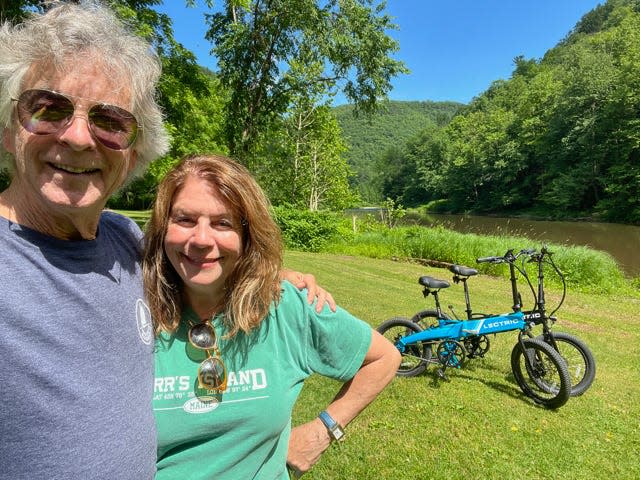
We were stunned in January when the nearly 100-year-old house we’d owned in West Palm Beach’s Flamingo Park neighborhood for 33 years sold for far over asking price, at the manic height of last winter’s South Florida real estate madness. Two days later, houseless, we bought a home on wheels.
Our Thor Delano is essentially a 7-foot wide, 11-foot-tall box bolted onto a Mercedes Sprinter van, which is to say it’s very large Amazon delivery van.
But this one promised to deliver adventure instead of printer ink and cat toys. A wall slides out to accommodate a Murphy bed and a dining booth. Inside, it was as glitzy as a cruise ship, with shiny wood cabinetry, taupe leatherette upholstery, two closets and most critically, a full bathroom.
No more dodging daddy long legs in campground showers for me.
I’d been retired from my Palm Beach Post reporting job for four years, as C.J., a former photojournalist-turned-architectural photographer, slowly wound down his business to the point he could leave for months at a time.
Our plan was to become part-time nomads, following spring north for our first trip, staying in state and national parks from the U.S. into Canada, yet with the luxury of hot showers and a comfortable bed.
By mid-May, we’d stuffed all the furniture our kids didn’t want into a small rental house and two warehouses. A kind friend signed on to stay with our three cats. We bought two folding electric bikes, and a Mini Cooper to tow behind our new rig. (This meant we could never back up more than a few inches unless we unhooked.)
We headed north.
4 tips for keeping things fun, sexy in your long-term relationship
Are you getting your daily steps in? Walking could save your life.
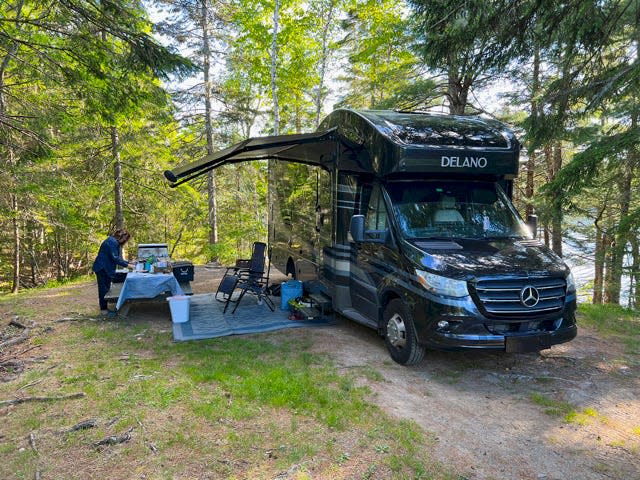
Not as simple as putting it in drive
We hadn’t counted on the cold. Or the rain.
Summer arrives like a brash, over-eager guest in South Florida, but it was a shy no-show by the time we got to one of our favorite spots in the Virginia Highlands.
We camped in the cold rain for a night, then realized that, unlike our previous analog camping vehicles, moving was easy. Sort of.
I always describe my husband as the guy who gets more done by 9 a.m. than most of us do all day. I am the dreamy opposite, especially in retirement — which has been the subject of some consternation at home.
At first, it took nearly an hour and half to get on the road. We had to work together, consulting several of the RV’s often incomprehensible manuals.
“It says to have the engine, generator or electrical power on to retract the stabilizers. Or, is it two of the three?”
“Is the refrigerator supposed to be working on propane or DC power?”
“You have to engage the emergency brake, then turn on the engine to bring in the slide. Not the other way around.”
“The awning won’t retract.”
“That’s because the engine has to be off.”
“Why is water streaming out of the tank when we just filled it?”
“Oh, #$*&.”
All that must be done before we could drive to the place where you dump the gray water tank and the black tank. (Oh, the horrors of the black tank.)
There was also the matter of hooking the Mini to the camper, involving heavy chains and a hitch called the "Blue Ox."
But then, I never had to deal with most of that. C.J., more patiently than I thought possible, managed to do almost all the grunt work, while I secured the inside of the RV and put on makeup. Yes, even when camping.
By the time we returned to Florida, we could pack up and hook up in 20 minutes.
And by “we,” I mean “he.”
Getting connected once we were unplugged
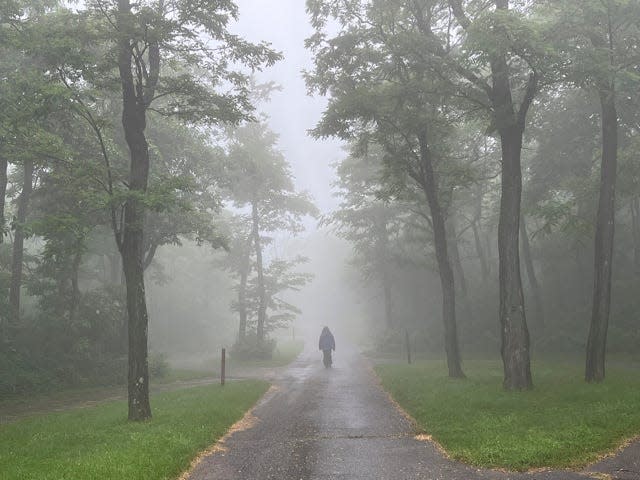
From frigid, rain-soaked Virginia, we headed north, hoping we’d encounter a spring full of sunshine and lilacs, with some moose, seals and maybe a puffin thrown in.
The rain did not let up in Pennsylvania, where we'd planned to ride our new electric bikes through the Pine Creek Gorge, known as the “Eastern Grand Canyon,” so we continued on, knowing we could stop by on our return in a few weeks.
Mountains and isolation meant we had little to no internet service in many places, which we gradually came to appreciate. The lack of news alerts. Of pinging texts. Of Instagram updates. All that constant connection with the world had vanished.
So, we connected with each other. Our half-baked plans had gone awry, but we were having a blast.
In our new unhurried world, we met in the middle, between his natural urgency and my sanguine laziness. We remembered how to be kind to one another. Why we liked each other. Why we loved each other.
We haven’t always been so understanding.
But now, no work, computer, phones, pets or kids demanded attention.
It was like being in suspended animation, floating beyond all the quotidian chores and aggravations that have made up our lives for decades. If we didn’t get somewhere on Wednesday, we’d be there Thursday. Or Friday.
After starting out cautiously, within a week C.J. was driving our rig with casual elan, as it lumbered bullish down the road in the right lane at a leisurely 61 mph, thwarting merging traffic through 12 states and three provinces.
That pace, our dashboard computer told us, gave us the best gas mileage, a critical consideration when diesel was going for as much as $6.50 a gallon in some areas.
We lazed through cold days and nights, furnace on, rum Old-Fashioned in hand, rain hammering the roof, having uninterrupted conversations seemingly for the first time in decades.
It was odd re-discovering this person that had been by my side for so long.
We laughed. A lot. Especially when the inevitable happened.
Pulling out of a campsite one morning, I screamed at him to stop.
“Why are you yelling?”
“Why are you driving off with the electrical cord still attached?”
When twice on cold mornings I ran the water tank dry with shampoo still in my hair, despite the sensor showing it was two-thirds full, C.J. simply said, "I'll heat up water," and then poured it, deliciously warm, over my sudsy head.
A few days later, he made sure it wouldn’t happen again, MacGyvering a small pump to fill the tank when we are camping without a water hook-up.
He solves my life.
In search of sun and antlers
Vermont was sunny. But by the time we were camped on New Hampshire’s wilderness Kancamagus Highway, we were again living among cloud banks that softened every outline while cold rain froze our thin Floridian blood.
Moose viewing hopes were high here, since we saw a mother and baby moose on this highway 35 years ago. But this time, the moose had vamoosed.
There were a few minutes of excitement after a young bear strolled through the campsite across the road, but rangers on golf carts quickly herded it away before we caught a glimpse.
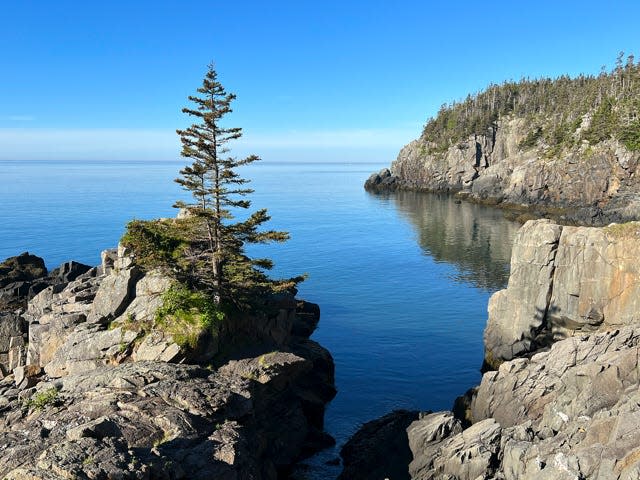
Maine was next, a state we’ve loved since traveling there before we were married. Gorgeous but cold and rainy before days of sun. Lobster for lunch and/or dinner. After staying with friends in their waterfront home near Brunswick, we camped in a state park in Camden, the Palm Beach of Maine, with its pricey shopping and aggressively groomed 19th century manses.
Then northern Maine, as beautiful a place as exists on earth. We hiked one of the conservation areas Mainers have zealously preserved, on high, fir tree-laden cliffs overlooking a sapphire Atlantic. A perfect day.
In Lubec, Maine, the easternmost town in the U.S., first light in early June was just after 3 a.m. while official sunrise was 4:42 a.m. By 7 a.m., it looked like noon, with air as clear as just washed crystal.
We saw no moose in Maine, either.
Border crossing
The Canadian border had opened a few weeks earlier as COVID waned; but until we tried to cross into New Brunswick at Calais, which Mainers pronounce as “callous,” we didn’t realize we were carrying contraband.
“Got any chicken? Eggs?” asked the nice Canadian Border Services agent.
“Both,” replied C.J.
“I’m sorry, but you’ll have to hand them over,” she said, informing us of a U.S. avian flu outbreak that Canada did not want imported.
“Any cannabis?”
Since C.J. has a Florida medical marijuana license, and cannabis is legal recreationally in both Maine and Canada, we weren’t concerned about harboring any illicit substance.
However, U.S. federal law rules the territory at the border, she explained, so for the stretch of a few hundred feet, my husband’s vape pen was labeled a Schedule I dangerous drug. It joined our frozen chicken breasts as interdicted criminal substances.
“The good news is there’s a dispensary a few blocks away on the Canadian side,” she said.
Canada Nice, indeed.
Why does a moose stand on the road?
New Brunswick looked freshly washed.
At Fundy National Park, we slept deeply in the dark woods.
Maybe the colossal stretches of forest were drugging us.
In Japan, “forest bathing” is part of preventive health care. Adherents say inhaling the organic compounds exhaled by trees, called phytoncides, can be an antidote to urban living, reducing stress, lifting mood and improving sleep.
We certainly felt calm and happy, sleeping up to 10 hours among the comforting trees.

We emerged astonished to see the Bay of Fundy’s extreme tides had left fishing boats balancing on their keels. In the tiny village of Alma, we had some of the best meals of our entire trip at Tipsy Tails, a small restaurant whose well-traveled owner made creative use of the halibut and haddock from the teetering boats on the mud below.
Near dark, we went looking for moose, with a pint of Fireball to keep us warm.
“Moose come out of the woods after dark to stand on the roads so the wind can blow away any bugs,” a ranger told us. “Also, the road is warmer than the ground. But they’re not very smart, so they get hit a lot. A collision can be fatal, for you and the moose.”
Since we were driving the little Mini, we went slowly, down access roads and into picnic areas.
But nothing. I’m a moose Jonah.
Beware the really high tides
At low tide, we walked on the ocean floor at Hopewell Rocks Provincial Park, at the eastern end of the Bay of Fundy, where the highest tides on earth — up to 53-feet — have carved Seussical figures out of the red sandstone cliffs. These tidal surges contain 175 billion tons of water, more than all the water in all the world’s rivers, the signs told us. As the tides begin trickling back in, rangers comb the coastline for lagging tourists in danger of being trapped by the rising water.
After crossing the 8-mile Confederation Bridge into bucolic Prince Edward Island, we camped on the beach, where families of bald eagles were teaching their fledglings to hunt. When they weren’t snatching fish trapped by the retreating tides, they perched on the sand, unperturbed by nearby strolling humans.
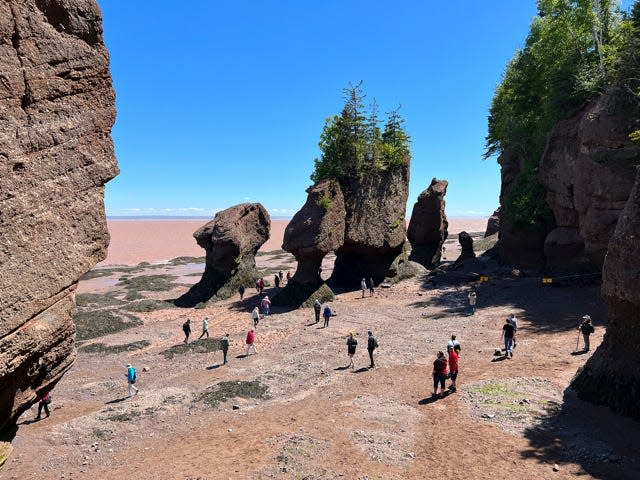
At the tip of Nova Scotia
“Are those signs in Gaelic?” I asked.
We had parked the RV in a campsite and were driving the Mini up the Cabot Trail on the craggy eastern coast of Cape Breton Island, the remote northern tip of Nova Scotia. It’s often compared to Scotland, from which many of the early settlers came. The scenery was breathtaking, as were some of the vertiginous drop-offs where the road seemed to hang over a cliff.
“Don’t look, just drive,” I warned C.J., who has a fear of heights.
The road signs were in English, Gaelic and sometimes Mi’kmaq, the language of the indigenous First Nations people of the Maritimes.
Signs on the western side of the island are in English and French. French immigrants, known as Acadians, arrived in the 17th century. Both cultures have tried to preserve their language, traditions and food ways. If we had been there a month later, we could have attended a Celtic music “ceilidh” or kitchen party, held in July and August.
The moose count is holding at zero.
An unplanned cruise
Driving south, we skipped Nova Scotia’s capitol of Halifax to stop in tiny Peggy’s Cove, a quaint, heavily-touristed fishing village bewilderingly built on huge boulders at the ocean’s edge. We couldn’t stay long in the icy wind, but it was easy to see why it’s one of the most photographed sites in the province.
At nearby Lunenburg, a Unesco World Heritage site, colorful original 18th- and 19th-century buildings border the fishing village’s waterfront.
On the docks, we admired the 112-foot Bluenose II, a replica of Canada’s most famous sailing ship and still the pride of fishing-centric Nova Scotia. The original fishing and racing schooner, which once plied the Grand Banks, is pictured on the back of the Canadian dime to commemorate its victory over the U.S. in the International Fisherman’s Cup trophy in 1921.
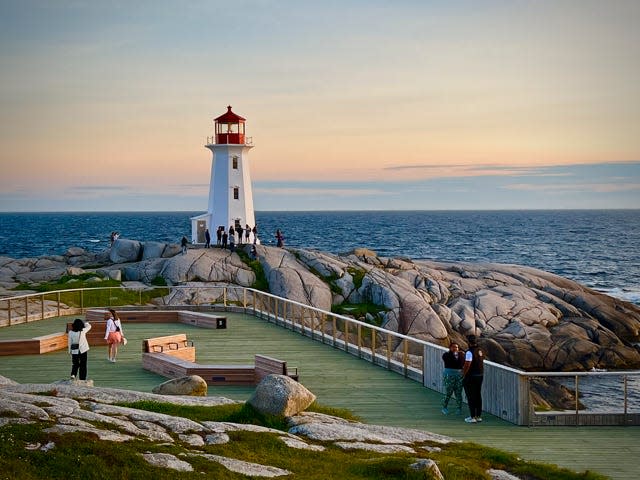
(No, we’d never heard of it either, and my entire family is Canadian — but it’s still a big deal for Maritime Canadians.)
“We still have room for this morning’s cruise,” a deck hand called out as we looked on. An hour later, we were onboard as the crew raised five of the ship’s immense, heavy canvas sails. Unlike being aboard the tall-ship replica boats at most tourist ports, we were actually sailing. C.J., a sailor currently without a boat, was a happy man.
Further south, we found Shelburne, a village of colonial houses with a sign proudly declaring it was founded by United Empire Loyalists in 1783.
My people. (My father’s family is descended from loyalists to the English crown; or if you like, traitors, who fled to Canada to avoid the dangerous new idea of democracy.)
It was time to head home.
Southward bound
I was weary of Canadian false advertising — a place where moose adorn socks, coffee mugs, sweaters and hats, but not a single one emerged from the woods to say, “eh?”
How Canada Nice is that?
After more than 4,000 miles, we were finally tired of driving. Our biggest mistake was trying to cover too much territory in six weeks.
We had approached the trip like a college survey course, covering just the highlights, but rarely delving deeper. We didn’t stay in one place for more than three nights. Next time, we’ll spend more time in fewer places.
We cut two days off the route back to the States via a ferry from Yarmouth, Nova Scotia to Bar Harbor, Maine.
In Pennsylvania’s summertime warmth, we were finally able to break out the electric bikes and ride the easy 17-mile rail trail between the steep walls of the Pine Creek Gorge, known locally as the “Little Grand Canyon.”
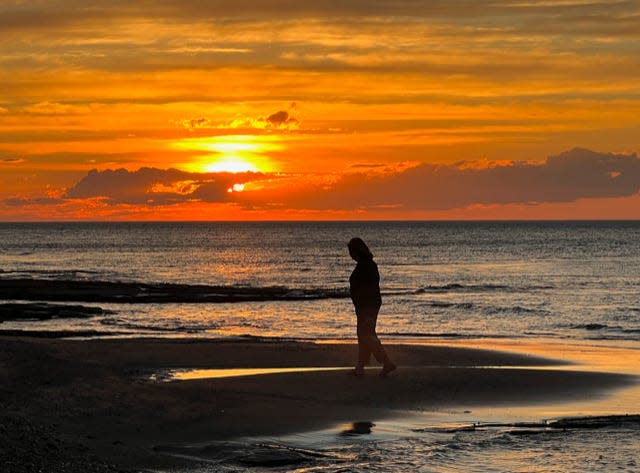
It was hot and sunny in Gettysburg, where we stayed with friends, one of whom was once the youngest battlefield guide in the park’s history. His riveting tour of the national park included a monument marking the farthest north the Confederacy ever penetrated Union territory — a monument that also carried his family name.
We hurried home through the now-stifling South, with a quick detour through Georgia’s lush Sea Islands.
Throughout the trip, I kept thinking about two novels: Annie Proulx’s epic “Barkskins” that chronicles the demise of the vast North American forests and Richard Power’s poetic, Pulitzer Prize-winning, “The Overstory,” a paen to trees.
Most of the vast forests we camped among were once cut, first to feed the British Empire’s appetite for sailing ships, then to build America. Once wood was replaced with steel and diesel replaced wood-burning steam engines, the forests grew back.
Given half a chance, nature renews and restores itself — and so, we found, can love.
Barbara Marshall is a former feature writer for the Palm Beach Post. She and her husband, C.J., live in a rented home in West Palm Beach — for now.
This article originally appeared on Palm Beach Post: Married 40 years, couple embarks on RV trip from Florida to Nova Scotia

